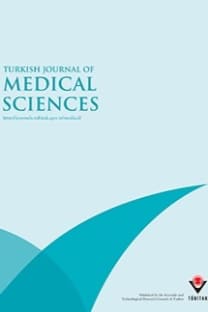Angiostatin levels in diabetes mellitus patients receiving insulin treatment: associations with laboratory findings, comorbidities, and medications
Angiostatin levels in diabetes mellitus patients receiving insulin treatment: associations with laboratory findings, comorbidities, and medications
___
- Lotfy M, Adeghate J, Kalasz H, Singh J, Adeghate E. Chronic complications of diabetes mellitus: a mini review. Curr Diabetes Rev 2017; 13: 3-10.
- IDF. Diabetes Atlas: Turkey Country Report. Brussels, Belgium: IDF; 2017.
- Tatar M. Management of diabetes and diabetes policies in Turkey. Global Health 2013; 9: 16.
- Praidou A, Androudi S, Brazitikos P, Karakiulakis G, Papakonstantinou E, Dimitrakos S. Angiogenic growth factors and their inhibitors in diabetic retinopathy. Curr Diabetes Rev 2010; 6: 304-312.
- Griscelli F, Li H, Bennaceur-Griscelli A, Soria J, Opolon P, Soria C, Perricaudet M, Yeh P, Lu H. Angiostatin gene transfer; inhibition of tumour growth in vivo by blockage of endothelial cell proliferation associated with a mitosis arrest. P Natl Acad Sci USA 1998; 95: 6367-6372.
- O’Reilly MS, Holmgren L, Shing Y, Chen C, Rosenthal RA, Moses M, Lane WS, Cao Y, Sage EH, Folkman J. Angiostatin: a novel angiogenesis inhibitor that mediates the suppression of metastases by a Lewis lung carcinoma. Cell 1994; 79: 315-328.
- Chi SL, Pizzo SV. Angiostatin is directly cytotoxic to tumor cells at low extracellular pH: a mechanism dependent on cell surface-associated ATP synthase. Cancer Res 2006; 66: 875- 882.
- Moser TL, Stack MS, Asplin I, Enghild JJ, Hojrup P, Everitt L, Hubchak S, Schnaper HW, Pizzo SV. Angiogenesis binds ATP synthase on the surface of human endothelial cells. P Natl Acad Sci USA 1999; 96: 2811-2816
- Semeraro F, Cancarini A, dell’Omo R, Rezzola S, Romano MR, Costagliola C. Diabetic retinopathy: vascular and inflammatory disease. J Diabetes Res 2015; 2015: 16
- Friedewald WT, Levy RI, Fredrickson DS. Estimation of the concentration of low-density lipoprotein cholesterol in plasma, without use of the preparative ultracentrifuge. Clin Chem 1972; 18: 499-502.
- Levey AS, Stevens LA. Estimating GFR using the CKD Epidemiology Collaboration (CKD-EPI) creatinine equation: more accurate GFR estimates, lower CKD prevalence estimates, and better risk predictions. Am J Kidney Dis 2010; 55: 622-627.
- O’Reilly MS, Holmgren L, Chen C, Folkman J. Angiostatin induces and sustains dormancy of human primary tumors in mice. Nat Med 1996; 2: 689-692.
- Sodha NR, Clements RT, Boodhwani M, Xu SH, Laham RJ, Bianchi C, Sellke FW. Endostatin and angiostatin are increased in diabetic patients with coronary artery disease and associated with impaired coronary collateral formation. Am J Physiol Heart Circ Physiol 2009; 296: 428-434.
- Matyal R, Mahmood F, Robich M, Glazer H, Khabbaz K, Hess P, Bianchi C, Hagberg R, Hu SX, Sellke FW. Chronic type II diabetes mellitus leads to changes in neuropeptide Y receptor expression and distribution in human myocardial tissue. Eur J Pharmacol 2011; 665: 19-28.
- Chung AW, Hsiang YN, Matzke LA, McManus BM, van Breemen C, Okon EB. Reduced expression of vascular endothelial growth factor paralleled with the increased angiostatin expression resulting from the upregulated activities of matrix metalloproteinase-2 and -9 in human type 2 diabetic arterial vasculature. Circ Res 2006; 99: 140-148.
- Bakhashab S, Ahmed FW, Schulten HJ, Bashir A, Karim S, Al-Malki AL, Gari MA, Abuzenadah AM, Chaudhary AG, Alqahtani MH et al. Metformin improves the angiogenic potential of human CD34+ cells co-incident with downregulating CXCL10 and TIMP1 gene expression and increasing VEGFA under hyperglycemia and hypoxia within a therapeutic window for myocardial infarction. Cardiovasc Diabetol 2016; 15: 15-27.
- Bell DS. Advantages of a third-generation beta blocker in patients with diabetes mellitus. Am J Cardiol 2004; 93: 49B-52B.
- Li D, Li P, Guo Z, Wang H, Pan W. Downregulation of miR382 by propranolol inhibits the progression of infantile hemangioma via the PTEN-mediated AKT/mTOR pathway. Int J Mol Med 2017; 39: 757-763.
- Childers WK, Hollenbeak CS, Cheriyath P. β-Blockers reduce breast cancer recurrence and breast cancer death: a metaanalysis. Clin Breast Cancer 2015; 15: 426-431.
- Albini A, DeCensi A, Cavalli F, Costa A. Cancer prevention and interception: a new era for chemopreventive approaches. Clin Cancer Res 2016; 22: 4322-4327.
- Pettersson US, Henriksnäs J, Jansson L. Reversal of high pancreatic islet and white adipose tissue blood flow in type 2 diabetic GK rats by administration of the beta3-adrenoceptor inhibitor SR-59230A. Am J Physiol Endocrinol Metab 2009; 297: E490-494.
- Yamahara K, Min KD, Tomoike H, Kangawa K, Kitamura S, Nagaya N. Pathological role of angiostatin in heart failure: an endogenous inhibitor of mesenchymal stem-cell activation. Heart 2009; 95: 283-289.
- Sima J, Zhang SX, Shao C, Fant J, Ma JX. The effect of angiostatin on vascular leakage and VEGF expression in rat retina. FEBS Lett 2004; 564: 19-23.
- Spranger J, Hammes HP, Preissner KT, Schatz H, Pfeiffer AF. Release of the angiogenesis inhibitor angiostatin in patients with proliferative diabetic retinopathy: association with retinal photocoagulation. Diabetologia 2000; 43: 1404-1407.
- ISSN: 1300-0144
- Yayın Aralığı: 6
- Yayıncı: TÜBİTAK
Ersöz GONCA, Figen BARUT, Deniz ŞAHİN
İsmail NALBANT, Can TUYGUN, Ufuk ÖZTÜRK, Hasan Nedim Göksel GÖKTUĞ, Ahmet Nihat KARAKOYUNLU, Volkan SELMİ, Muhammed Abdurrahim İMAMOĞLU
Erel İÇEL, Halil İbrahim İMAMOĞLU, Nurettin AKYOL, Adem TÜRK, Aykut IÇEL
Mustafa ATASOY, Emin ÖZLÜ, Ragıp ERTAŞ, Atıl AVCI, Muhammet Reşat AKKUŞ, Kemal ÖZYURT, Çiğdem KARAKÜKÇÜ
İbrahim KILINÇ, Adnan KARAİBRAHİMOĞLU, Başar CANDER, Sedat KOÇAK, Alpay TUNCAR, Mehmet ERGİN, Mehmet GÜL, Zerrin Defne DÜNDAR, Tamer ÇOLAK, Abdullah Sadık GİRİŞGİN, Kadir KÜÇÜKCERAN
Yong Peng LIM, Nurlia YAHYA, Azarinah IZAHAM, Esa KAMARUZAMAN, Muhammad Zurrusydi ZAINUDDIN, Wan Rahiza WAN MAT, Shereen Suet Ping TANG, Jaafar Md ZAIN, Siti Nidzwani MOHAMAD MAHDI
Dilek DEMİREL, Tuğba AYÇİÇEK, Seda GÜN, Sertaç HANCIOĞLU, Ünal BIÇAKCI, Ender ARITÜRK, Ferit BERNAY
Eda GÜRÇAY, Ebru KARACA UMAY, Güleser SAYLAM, Erhan ÖZTÜRK, Aytül ÇAKCI, İbrahim GÜNDOĞDU, Özgür KARAAHMET, Yasemin EREN, Volkan YILMAZ
